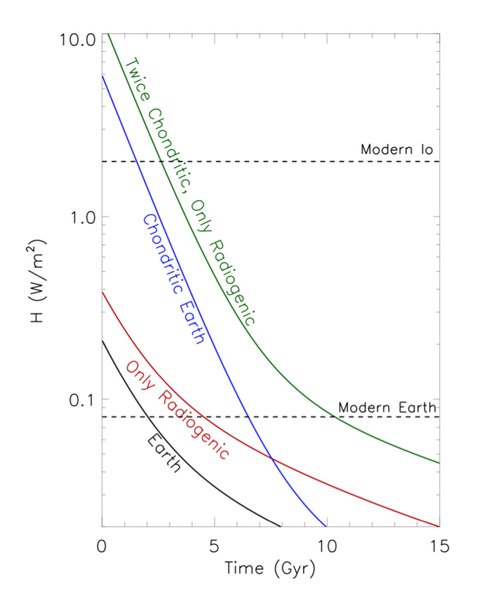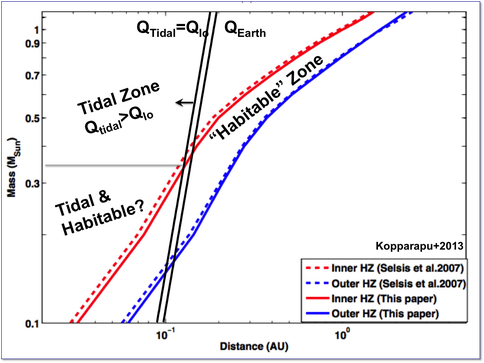2014 Annual Science Report
 VPL at University of Washington
Reporting | SEP 2013 – DEC 2014
VPL at University of Washington
Reporting | SEP 2013 – DEC 2014
Planetary Surface and Interior Models and SuperEarths
Project Summary
We use computer models to simulate the evolution of the interior and the surface of real and hypothetical planets around other stars. Our goal is to determine the initial characteristics that are most likely to contribute to making a planet habitable in the long run. Observations in our own Solar System show us that water and other essential materials are continuously consumed via weathering (and other processes: e.g., subduction, sediment burial) and must be replenished from the planet’s interior via volcanic activity to maintain a biosphere. The surface models we are developing will be used to predict how gases and other materials will be trapped through weathering and biological processes over time. Our interior models are designed to predict tidal effects, heat flow, and how much and what sort of materials will come to a planet’s surface through resurfacing and volcanic activity throughout its history.
Project Progress
Work this year focused on the nature and evolution of the Earth’s mantle and crust shortly after the Moon-forming impact and also the formation of habitable fractures in the Earth’s crust following subsequent impacts. VPL team members also participated in the ASU NAI Stellar Stoichiometry Workshop Without Walls and contributed to the conference’s review paper. Thermal-orbital planetary evolution was explored with the coupling of orbital tidal evolution and interior models and work continued on weathering models to understand the effects of weathering in low oxygenation states that may have been present in the Proterozoic.
Dynamics of the earliest earth, the effects of asteroid impacts, and evidence for early life retained in the mantle and crystalline crustal rocks:
Sleep et al., (2014) discussed the state of the mantle and crust soon after the moon-forming impact, the influence of lunar induced earth-tides on these zones, and the fate of CO2 in the mantle and atmosphere in the Hadean. Sleep and Lowe (2014) examined the physics of crustal fracturing and dike formation triggered by a large meteorite impact in the Barberton greenstone belt, South Africa.
Influence of chemical composition on planetary evolution: Barnes and Kopparapu participated with the ASU lead team and others in the Stellar Stoichiometry Workshop Without Walls and associated follow-on research activities. This meeting discussed how chemical composition affects virtually all aspects of astrobiology, from stellar astrophysics to molecular biology. The participants focused on the measurement of chemical abundances and the effects of composition on processes from stellar to planetary scales. Self-consistent surveys of stellar abundances show that there is still substantial variation (factors of ∼ 2) in the ratios of common elements (e.g., C, O, Na, Al, Mg, Si, Ca) important in rock-forming minerals, atmospheres, and biology. The effects of composition on stellar evolution are substantial, and coupled with planetary atmosphere models can result in predicted habitable zone extents that vary by many tens of percent. Variations in the bulk composition of planets can affect rates of radiogenic heating and substantially change the mineralogy of planetary interiors, affecting properties such as convection and energy transport. Barnes showed that if one allows for a planet to form with isotopic abundances that are twice-chondritic, the resultant radiogenic heating may cause Earth-like exoplanets and super-Earths to experience Io-like levels of surface energy flux levels for the first 1-2 Gyr (Young et al., 2014)
Thermal-Orbital Planetary Evolution: Driscoll and Barnes examined the thermal, orbital, and magnetic evolution of terrestrial planets by coupling tidal dissipation in the interior to the thermal and orbital state of the planet. Internal heat associated radioactive decay, secular heat, and tidal dissipation is balanced by convective and advective (melt) heat loss. This balance controls the cooling rate of the interior and the geological time over which a planet may be habitable. We found that for Earth-mass planets around M dwarfs (0.1 solar-mass) initially in the inner habitable zone (HZ) circularize quickly (< 200 Myr) and experience a burst of tidal heating that prolongs the partial-magma ocean stage, while Earths in the outer HZ do not circularize before 10 Gyr and experience a persistent steady tidal heating rate of ~ 10 TW. If the orbit of the planet is fixed (for example by an additional planet), then an equilibrium state is reached where tidal heating+other internal heat sources balance the surface heat flux, and mantle temperature is constant.
Weathering Models: Bolton used a reactive transport model to simulate weathering at planetary surfaces. We continued production runs to quantify CO2 drawdown from the atmosphere by weathering of soils derived from idealized granite and basalt rock types. This modeling is being done to find the influence of atmospheric composition, temperature, and infiltration rates on weathering related CO2 consumption. A vadose zone model is being tested. We are exploring the influence of heterogeneous permeability on effective kinetic rates in 2D soils. We have examined pyrite and organic matter (OM) oxidation rates in eroding shales under atmospheres with 0.1% of the present atmospheric level of oxygen where most of the pyrite and OM erodes off the soil surface before significant oxidation.
Publications
-
Sleep, N. H., & Lowe, D. R. (2014). Physics of crustal fracturing and chert dike formation triggered by asteroid impact, ∼3.26 Ga, Barberton greenstone belt, South Africa. Geochem. Geophys. Geosyst., 15(4), 1054–1070. doi:10.1002/2014gc005229
-
Sleep, N. H., Zahnle, K. J., & Lupu, R. E. (2014). Terrestrial aftermath of the Moon-forming impact. Philosophical Transactions of the Royal Society A: Mathematical, Physical and Engineering Sciences, 372(2024), 20130172–20130172. doi:10.1098/rsta.2013.0172
-
Young, P. A., Desch, S. J., Anbar, A. D., Barnes, R., Hinkel, N. R., Kopparapu, R., … Truitt, A. (2014). Astrobiological Stoichiometry. Astrobiology, 14(7), 603–626. doi:10.1089/ast.2014.1143
-
PROJECT INVESTIGATORS:
-
PROJECT MEMBERS:
Peter Driscoll
Project Investigator
Rory Barnes
Co-Investigator
Kevin Zahnle
Co-Investigator
Ravi Kopparapu
Collaborator
-
RELATED OBJECTIVES:
Objective 1.1
Formation and evolution of habitable planets.
Objective 1.2
Indirect and direct astronomical observations of extrasolar habitable planets.
Objective 4.1
Earth's early biosphere.
Objective 5.2
Co-evolution of microbial communities
Objective 6.1
Effects of environmental changes on microbial ecosystems



